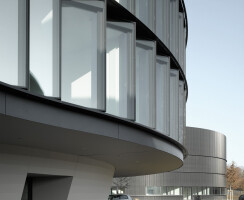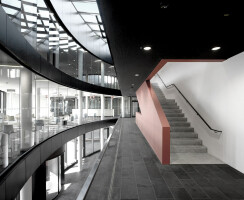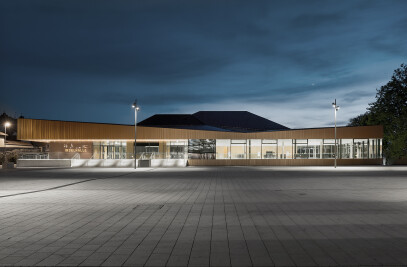On 4 December 2013, at ESO Headquarters in Garching bei München, Germany, an official inauguration ceremony was held for the new office extension.
The unveiling of the extension marks an important day in ESO’s history as it will not only bring all of ESO’s Garching staff together on one site, facilitating valuable collaborative work, but will also provide a technical building for ESO’s most advanced instruments to be assembled, tested and upgraded. These two buildings — an office building of 10.300 square metres and a technical building of 2.900 square metres — and their surroundings cover more than double the current area of the ESO Garching Headquarters. This additional space was much needed as ESO staff is currently spread across different locations in the Garching campus area.
Furthermore, with the European Extremely Large Telescope on the horizon, ESO needed a cradle for the technological innovations that the ambitious project will require. The technical building — which will also host one of the largest computer archives of astronomical data in the world — will be the focal point of this work. The extension has been designed to be in keeping with the original building. The office building, which follows the same curved shape, makes extensive use of natural light sources and has two inner courtyards. The technical building is a cylinder with a diameter matching the size of the 39 metre primary mirror of the E-ELT.
Both new buildings have been labelled green buildings as their energy consumption will be significantly lower than is typical for buildings of this size. This is due to the well-insulated façade and because the office building is heated and cooled through concrete core activation — for which groundwater is used together with a heat pump — and supplied with district heating using geothermally heated water.
Architectural Concept
Existing situation and design objective The existing ESO Headquarters building has an outstanding position on the Garching research campus. It lies on the southern fringe of the campus site and is the starting point for the axis of the “Campusband”. The building is noted for its unique concept, symbolising through its architectural design the scientific study of the cosmos carried out at ESO.
The building stands alone at the edge of Garching’s green belt, and its elegant curves express a successful symbiosis between landscape and architecture, by embracing the natural surroundings and forming individual courtyard spaces. Keeping the character of the site and emphasising the communicative atmosphere in close touch with the surrounding countryside form the key features for this design proposal.
Design concept The architectural concept for the extension buildings takes account of both the established green belt beyond the southern border of the research campus and the extrovert character of the existing headquarters building. The result are open and individual buildings that blend both functionally and formally with the existing headquarters, while still respecting its prime position with main entrance, reception and public areas. Since the new office and conference building is located south of the existing headquarters and therefore reaches even further into the greenbelt, it is conceived as a structure embedded in its natural surroundings. The height does not exceed three storeys, in keeping with the majority of the existing building, other than the two five-storey office rings towards the southeast.
The circle dominates as an architectural component in the existing headquarters building. In this context it refers to scientific communication, but the concept is taken over and transformed by the extension building. While the existing building is composed from a series of open arcs opening out into the surrounding countryside, the new building forms a continuous band of convex and concave circles that enclose an inner circulation zone, and communicative and public facilities such as the auditorium, council room and cafeteria. Since the main public entrance to the existing headquarters is via a ramp from the northwest at a height of about 4 metres above ground, and the ground floor is mainly used for internal access and delivery, the new building is conceived with its two main floors floating above ground level. These two main floors rest on structural and functional parts of the building that contain the auditorium, delivery areas and covered bicycle and car parks. In order to avoid breaching the groundwater level, the basement areas are reduced to the required minimum in order to both a void the risk of flooding and to reduce building costs for waterproof concrete structures. One basement level is located in the area of the auditorium.
Access and circulation The main external entrance remains in the existing headquarters building. The internal connection between the existing building and the extension is at the point of the existing cafeteria and is via an enclosed bridge. Car access and the second entrance to the extension building are provided via the access road to the additional 100 parking spaces northeast of the existing building. These are arranged in a ring around the functional and structural parts of the building, on the ground floor of the new office and conference building.
This entrance includes a taxi drop-off zone and a separate reception, which can also be used for major events such as congresses or seminars.
Architectural concept, appearance The curved envelope of the extension building with its fully glazed façade provides the illusion of a structure floating above ground on clad supports. During the day both the existing headquarters and the surrounding countryside are reflected as fractured images through the shingled folded façade. In the evening the building is lit from inside and optically opens fully outwards over the entire building height since the façade is constructed without parapets. In addition to this, the floating structure can be dimly illuminated from below by downlights embedded in the suspended ceiling.
Internal organisation The auditorium, the cafeteria and the council room of the new building are situated in the area next to the existing building and will thus form the balance point of the new layout for the ESO site. Additional communicative centres with reading areas are arranged on both upper floors around the two circular cut-outs with views to the outside. One of these cut-outs, with a diameter of 8.20 metres, has exactly the same dimensions as the large VLT mirrors at the Paranal Observatory in Chile (A uerWeber designed the Residencia at ESO’s Paranal Observatory, which was a recipient of both a LEAF Award in 2004 and a Cityscape Architectural Review Award in 2005). Similar reference dimensions to other telescopes of the ESO fleet can be found throughout the buildings. 12 m2 offices are placed in the outer office ring and have views out onto the open country. Larger 18 m2 offices, as well as the meeting rooms, are arranged as two inner office rings around the courtyards. The council room opens onto winter garden that can be used as a recreation area during conference breaks.
Landscape design The planted areas between the existing building and the new office and conference building and will be developed in accordance with the overall landscaping concept of the ESO site. The new office and conference building should appear as a floating structure above the existing landscape, so paved surfaces should be kept to a minimum and green surfaces like lawn or grassland be brought as close as possible to the new building. Paved areas for pedestrian and car access will be carried out as ground asphalt. The plantation of additional trees should respect the character of the site where open fields meet densely wooded areas. Trees are planted only in a few selected areas (e.g. in the entrance area) to provide sight lines rather than to obstruct the view out over the surrounding country.
Structural concept The first and second floor levels rest on a sub-construction, consisting of the first floor slab supported by circularly arranged concrete columns on the ground floor, together with inclined cladding that forms sculptured spaces. As the circular floor slab and shear wall construction are used in only the second of the two upper floors, a column free cantilever will be possible, thus enhancing the perception of a structure floating above ground level. The first floor slab is supported by tensioned concrete columns suspended from shear wall constructions on the second floor level allowing the design of open-plan areas on the first floor.

































